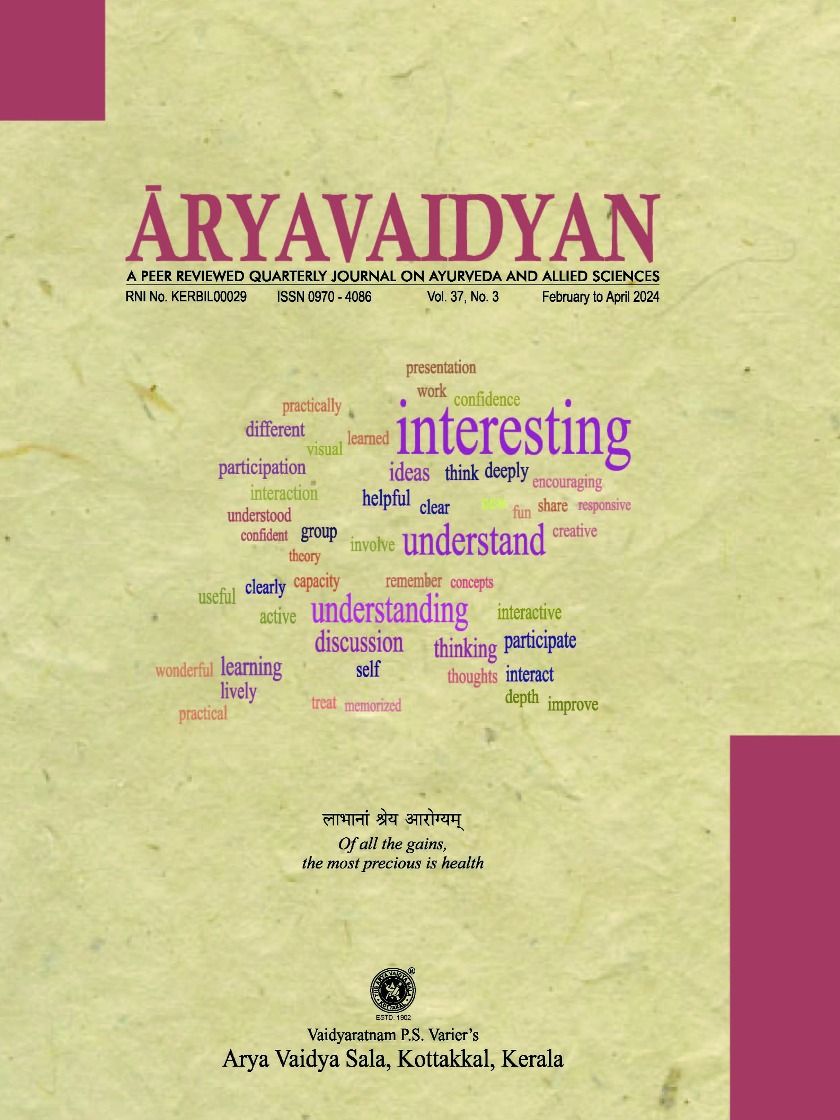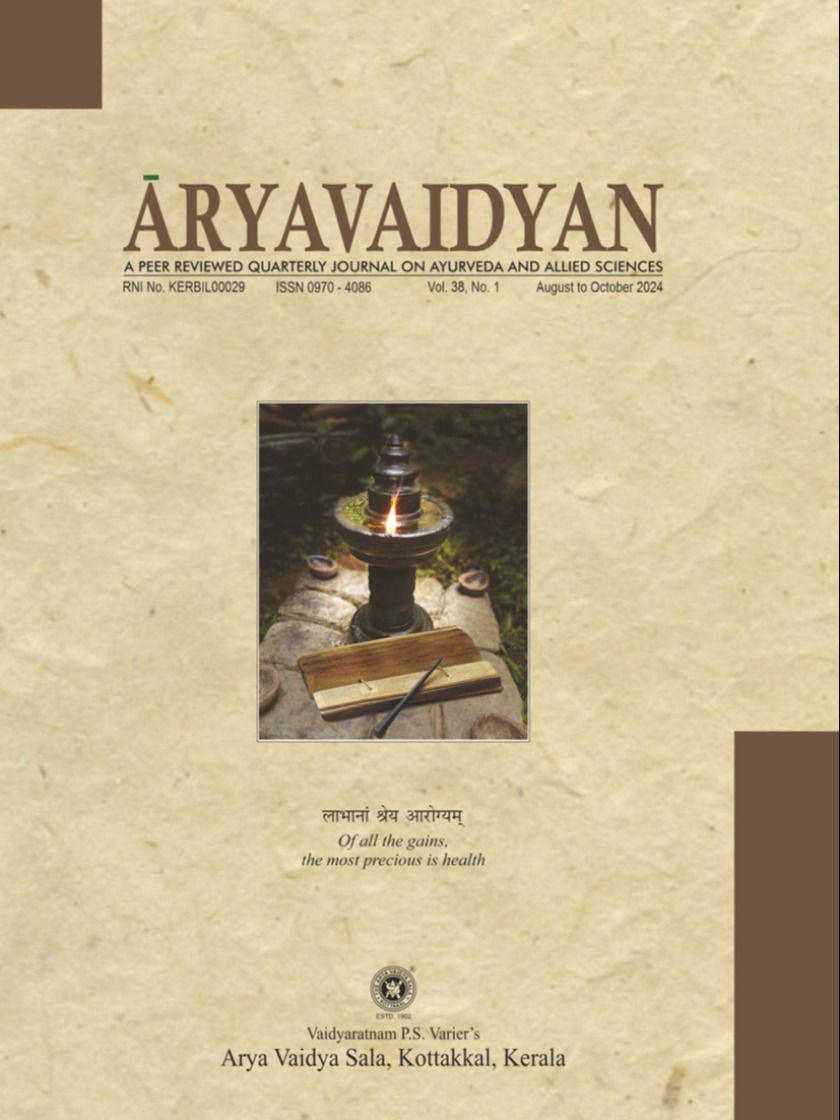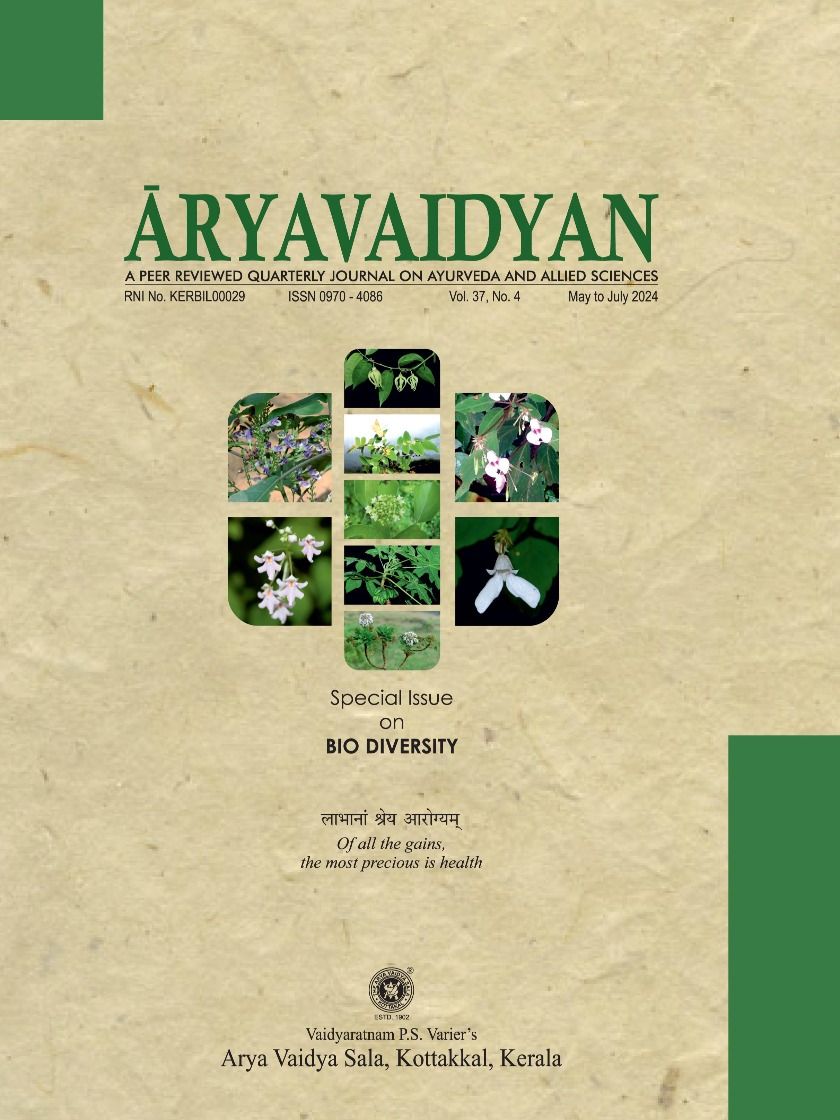
Contents
- By Aswathy V
- Kriyasarira
- Jul 19, 2023
The efficacy of conducting small group discussions post didactic lecture method for in-depth understanding of basic concepts of Ayurveda among first year BAMS students - A Single arm interventional study on new pedagogy in Ayurvedic teaching
- By Sree lekshmi. G. A
- Manorogacikitsa
- Jan 01, 2024
AYURVEDIC MANAGEMENT OF SUBSTANCE INDUCED PSYCHOTIC DISORDER - A CASE REPORT
- By SARADA M K
- Ayurveda Literary Studies
- Jan 18, 2024
Exordia of Jalpakalpataru Vyakhya of Kaviraj Gangadhar Ray on Charaka Samhita- A Literature Review
- By Sureka Hosamani
- Dravyagunavijnana (Pharmacology)
- Aug 01, 2024
Study of UV Vis and FTIR Absorption Spectroscopy in ayurvedic cancer cure medicinal plants
- By Amritha A T
- Roganidana
- Nov 29, 2023
AYURVEDIC MANAGEMENT OF ARDITA WITH SPECIAL REFERENCE TO BELL’S PALSY : A CASE STUDY
- By Priya N K
- Book Review
- Jul 13, 2024
RELEVANCE OF PURIFICATORY TREATMENT IN DEGENERATIVE DISEASES- BOOK REVIEW
Editorial
Adaptations in Ayurvedic Practice
Prof. Murali K.
India is a country with multiplicities in geography, culture and language. This diversity is evident in the recitations of Vedas, musical/dance performance, in the use of Sanskrit language and many other. Interestingly, the sameGithagovindam is performed as Manipuri dance and recited as sopaana-sangeetam in Kerala. Ayurveda is no exception to this. While the treatises and the conceptual frame work remain thesame,its application and practice vary in many ways region to region. The theories are interpreted differently, based on the geography (desa) and the seasons (kaala) experienced in a particular region. This allows the adaptations that are suitable for thepopulation.
Many of these adaptations are made to address the challenges faced by ayurveda during different times. Climate, for example, has a significant impact. The theory of samyak/asamyakyoga of kaala (proper/impropermanifestations seasons) is an established concept in ayurveda. The adverse effects of climate can be countered with appropriatertu-caryaa.However, while adapting this to a specific region, factors such as local climate and lifestyle habits including the dietary one, of the population must also be considered. This phenomenon is not related to India alone. There is an innate system inayurvedato accommodate these diversities its practice. It is with this ability ayurvedaspread to the neighboringcountries like Nepal and Srilanka etc. which share a lot with Indian culture [1].
A closer examination of the classical texts reveal thatayurveda as a pluralistic medical system in itself.Charaka’s observation about the existence of different schools is significant in this aspect [2]. The standardized form of ayurveda had evolved probably through the convergence of various schools. The differences inthe opinions on veerya, vipaaka,aamaetc., seem to reflect this plurality. Multiple approaches to treat a disease and the availability of several drug formulations for a single disease also exemplifies this. Ayurveda does not insist on rigid uniformity in theory and practice.This flexibility is one of the strengths of this knowledge system.
Recently, there are discussions about the need to strike a balance between standardization and customization. In recent time,this equilibrium has been lost with too much emphasis on standardization. It is necessary to restore the balance and prioritize customization for the benefits of patients, clinicians and thehealth care system [3]. This approach is reflected in the concept of ‘personalized medicine.This customization does not solely depend on the patient.The external environment, which is inseperable from the individual must also to be taken to account. The geography of patient’s place of origin and living isimportant. In the context of healthy drinking water Aacaarya cautions against consuming water from areas outside of one’s living area[4].Susruta suggests using herbs from one’s own surroundings for treatment. It should be noted that desa (geographical area) is also related to saatmya (habituation).
Both availability and non-availability of certain drugs impact the choices made. The botanical source of a specific drug maynot be available in another area for understandable reasons, but there may be an abundance of other herbs. This allows for alternative botanical sources of the drugs. This should not be considered substitution or adulteration. This inclusiveness is another aspect of the ‘regionalisation’ of ayurveda, which promotesthe acceptability and effectiveness of the entire system.
Kerala can be a model area where the adaptations in ayurvedic practice can be studied. The predominant use of herbs, variously medicated oils, and specifically modified methods of sneha and sveda are some the features ofthese adaptations. Another interesting factor is the Inclusion of coconut oil. This vegetable oil has been used for various purposes since the sixteenth century. Overtime,it has replaced gingelly oil especially for the externalapplication in skin diseases.
Further explorations from this perspective are necessary, with sufficient inputs from history and culturalstudies.
References:
1. Nordstrom CR. Exploring pluralism--the many faces of Ayurveda. SocSci Med.1988;27(5):479-89. doi: 10.1016/0277-9536(88)90371-1. PMID: 3227356.
2. CharakasamhithaVimaanasthaana 8/3
3. Sinsky CA, Bavafa H, Roberts RG, Beasley JW. Standardization vs Customization: Findingthe Right Balance. Ann Fam Med. 2021 Mar-Apr;19(2):171-177. doi: 10.1370/afm.2654. PMID:33685879; PMCID: PMC7939702.
4. AshtangahrdayamSootrasthaanam 5/19
Editorial Board
Chief Editor
Prof. K. Murali
Former Professor, Govt. Ayurveda College, Thrippunithura, Kerala
Sub Editors
Dr. A. Raghunathan Nambisan
Executive Editor
Dr. Devikrishnan K.
Chief Sub Editor
Advisory Board
Dr. P. Madhavankutty Varier
Patron
Prof. Banwari Lal Gaur
Former Vice Chancellor, DSRRAU, Jodhpur
Prof. K. Mohandas
Former Vice Chancellor, Kerala University of Health Sciences
Dr. P. Sankaran Kutty
Former Director, Ayurveda Medical Education, Govt. of Kerala
Dr. M.P. Eswara Sarma
Former Principal, VPSV Ayurveda College, Kottakkal
Dr. T. Sreekumar
Principal, PNNM Ayurveda College, Cheruthuruthy
Dr. M. Prasad
Professor, Ashtamgam Ayurveda Vidyapeedham, Vavanoor
Dr. Jose T. Paikada
Former Specialist Medical Officer, Indian Systems of Medicine
Dr. M.V. Vinod Kumar
Associate Professor, VPSV Ayurveda College, Kottakkal
Dr. K. Muraleedharan
Trustee & Additional Chief Physician, Arya Vaidya Sala, Kottakkal
Dr. P. Ramkumar
Trustee & Factory Manager, Arya Vaidya Sala, Kottakkal
Shri Ajay K.R.
Trustee & factory Manager, Avs Factory, Nsanjangud, Arya Vaidya Sala, Kottakkal
Shri P. Rajendran
Joint General Manager (Corporate Affairs), Arya Vaidya Sala, Kottakkal
Shri K.V. Ramachandran
Consultant, Arya Vaidya Sala, Kottakkal
Dr. Indira Balachandran
Project Director, Centre for Medicinal Plants Research, Arya Vaidya Sala, Kottakkal


